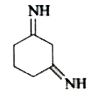Which of the following is least stable
The correct Answer is:D
To determine which of the given hydrides is the least stable, we can follow these steps:
Step 1: Identify the Group
The question refers to hydrides of alkaline earth metals, which include beryllium (Be), magnesium (Mg), calcium (Ca), strontium (Sr), barium (Ba), and radium (Ra). The hydrides in question are BeH₂, MgH₂, CaH₂, and BaH₂.
Hint: Remember that alkaline earth metals have two valence electrons, which influences the stability of their hydrides.
Step 2: Understand Stability Trends
As we move down the group from beryllium to barium, the size of the central atom increases. This increase in atomic size leads to a decrease in electronegativity, which affects the strength of the bond between the metal and hydrogen.
Hint: Consider how atomic size and electronegativity influence bond strength.
Step 3: Analyze Bond Strength
The bond strength between the metal and hydrogen decreases as the size of the metal atom increases. This means that the bonds in the hydrides become weaker as we go down the group. Weaker bonds are more likely to break, leading to lower stability.
Hint: Think about how bond strength relates to stability; weaker bonds mean less stability.
Step 4: Compare the Hydrides
Now we can compare the stability of the given hydrides:
- BeH₂ (Beryllium Hydride) - Stronger bond due to smaller size and higher electronegativity.
- MgH₂ (Magnesium Hydride) - Weaker than BeH₂ but still relatively stable.
- CaH₂ (Calcium Hydride) - Weaker than MgH₂.
- BaH₂ (Barium Hydride) - The weakest bond due to the largest size and lowest electronegativity.
Hint: Look for the hydride with the largest central atom for the least stability.
Step 5: Conclusion
Based on the analysis, BaH₂ (Barium Hydride) is the least stable hydride among the given options due to the weakest bond formed with hydrogen.
Final Answer: BaH₂ is the least stable hydride.
The question refers to hydrides of alkaline earth metals, which include beryllium (Be), magnesium (Mg), calcium (Ca), strontium (Sr), barium (Ba), and radium (Ra). The hydrides in question are BeH₂, MgH₂, CaH₂, and BaH₂.
As we move down the group from beryllium to barium, the size of the central atom increases. This increase in atomic size leads to a decrease in electronegativity, which affects the strength of the bond between the metal and hydrogen.
The bond strength between the metal and hydrogen decreases as the size of the metal atom increases. This means that the bonds in the hydrides become weaker as we go down the group. Weaker bonds are more likely to break, leading to lower stability.
Now we can compare the stability of the given hydrides:
- BeH₂ (Beryllium Hydride) - Stronger bond due to smaller size and higher electronegativity.
- MgH₂ (Magnesium Hydride) - Weaker than BeH₂ but still relatively stable.
- CaH₂ (Calcium Hydride) - Weaker than MgH₂.
- BaH₂ (Barium Hydride) - The weakest bond due to the largest size and lowest electronegativity.
Based on the analysis, BaH₂ (Barium Hydride) is the least stable hydride among the given options due to the weakest bond formed with hydrogen.
Topper's Solved these Questions
Similar Questions
Knowledge Check
Which of the following is the least stable ?
ACH3CH2+CH2BCH3+CH2CH2CH3CCH3−+C∣CH3−CH3DCH3−CH3∣C∣CH3−+CH−C6H5Which of the following is the least stable?
A B
B C
C D
D
Which of the following is the least stable carbocation?
ACH⋅3BCH3CH⋅2C(CH3)2CH⋅D(CH3)3C⋅
Which of the following is least thermally stable ?
View SolutionWhich of the following is the least stable carbanion?
View SolutionIn which of the following least stable compound is :
View SolutionWhich of the following is the least stable carbanion?
View SolutionWhich of the following is the least stable conformer of cyclohexane?
View Solution
